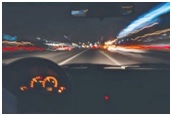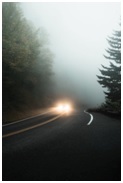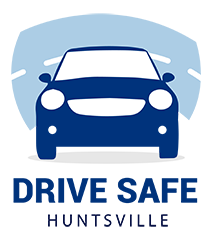Night Driving

You might be surprised to see that night driving is considered to be “less than ideal” road conditions. After all, you can be driving on a clear night with dry roads. But it all comes down to darkness and visibility. With darkness comes a serious drop in your ability to see things. While your vehicle is equipped with working headlights and streets are lit in many places, what you see when it’s dark can’t come close to what you see in daylight.
The decrease in visibility means you will have less time to react to unexpected hazards because you may not see them right away. Less reaction time translates into the need to stop or avoid more quickly. You may not see people or wildlife just off the side of the road. If they unexpectedly dart out in front of you, it may be too late before you can react.
Your vehicle headlights should enable you to see about 500 feet ahead. High beams should provide a clear view to about 350 feet. That assumes you have head lamps that are not burnt out and clean lenses. A good rule of thumb for night driving is to adjust your speed so that you can make a safe stop using only the distance ahead of you that is illuminated by your headlights.
In urban areas or business zones, you can expect well lit streets. In more rural areas, street lighting may be sparse if even there at all. Now you must rely solely on your headlights and your observation skills. At night, be more vigilant about what is happening ahead of you and off to your sides. Potholes or objects in the road will come upon you more quickly. The same is true for pedestrians, joggers, or cyclists. Always expect them any time of day. While they should wear reflective gear at night, some won’t. This is a dangerous situation for both them and you. If you even suspect you see a shadow or silhouette, assume it is a person or animal. Don’t wait until you come upon it to find out for sure.
Use your high beams at night, but be aware of when you should switch back to low beams. If you meet an oncoming vehicle, lower your high beams when you are within 500 feet of that vehicle. Dim your high beams when you close to within 200 feet or less of a vehicle you are following.

The law dictates that you must turn on your headlights one half hour after sunset to one half hour before sunrise. On top of that, keep your headlights on whenever you do not have a clear view at least 500 feet ahead. And remember, your headlights are not just there so you can see. Your headlights enable other drivers to see you.
If night travel takes you through or to an unfamiliar area, plan ahead. Plug your intended route into a GPS before you leave or consult a map or on line program for directions. You can be sure that route signs, other traffic signs, and especially street signs will be more difficult to read in the dark. You have enough to be watching for without having to strain to read or look for signs. If you are doing that, then you are not fully focused on the road.
Unfortunately, not all drivers will observe the high beam/low beam etiquette. So, at some point, you may find yourself driving right into the glare of an oncoming vehicle. Should this happen, look towards the white line on the right side of the road. Do not stare into the oncoming headlights. The careless driver will pass by soon enough. Adjust your rear view mirror if a driver behind you closes to less than 200 feet and neglects to lower the high beams. Many vehicles have rear view mirrors with day/night adjustments.

Never get a false sense of security at night. Much of the time you will encounter less traffic especially during overnight hours. All it takes, though, is ONE careless driver who is drunk or falls asleep behind the wheel or runs a red light. Traffic laws are in effect twenty four hours a day seven days a week. Some drivers forget that.
Breaking down at night presents additional challenges over and above having car trouble during the day. Less traffic at night means fewer drivers who may stop to help. If you must pull to the side of the road pull off completely. Activate your emergency flashers and raise your hood. It is always a good idea to stay with your vehicle until help arrives. Sometimes this is not possible. If you must search for assistance on foot, walk towards oncoming traffic. Carry a light or reflector if you have it.
Good defensive drivers carry emergency equipment. Among this equipment are highway flares or reflectors. When possible, light flares or place reflectors along the right side of the road. This will alert other drivers to your disabled vehicle. Place the devices anywhere between 100 to 500 feet behind your vehicle, depending on the road conditions and configuration.
